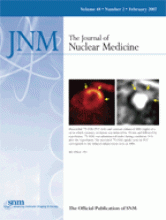TO THE EDITOR: In the study by Sisson et al. (1), the authors have attributed the “so-called stunning effect” to the early effects of the treatment dose on 131I accumulation. As noted in the accompanying invited perspective (2), this phenomenon has been described previously (3,4), but it does not preclude the existence of the stunning effect otherwise attributed to a pretreatment diagnostic dose of 131I. We would like to comment on the following points raised in the article.
As acknowledged by the authors (1), it is the absorbed dose—and less so, the administered dose—that will determine the effect of the 131I radiation on the tissues (5,6). Therefore, it is not surprising that this study found a lack of precise correlation between the administered 131I diagnostic dose (ranging from 18.5 to 74 MBq) and the measured treatment/diagnostic dose ratios. (However, Table 1 (1) does show the lowest ratio for the highest 37-MBq diagnostic dose group, even if this was not statistically significant.)
Second, it is technically challenging to accurately measure uptake of the posttreatment dose. The authors acknowledged their inability to do so at 24 h with patients given 5.5 GBq 131I treatments. We would further ask whether the linearity of such other measurements in the posttreatment time interval was validated, as this was not mentioned in the article.
Third, the authors stated the following in the Discussion under Literature Comparisons: “In only one publication was ablation observed less frequently in patients who received treatment preceded by diagnostic imaging than in patients who were treated without diagnostic imaging…” (1). In fact, there have been multiple other such reports. Lees et al. (7) reported that preablation diagnostic whole-body scanning performed in 36 patients with 185 MBq of 131I was associated with a 47% first therapy success rate, compared with 86% in the same number of patients who had been scanned with 740 MBq of 123I. A significantly greater number of total treatments and more total radioiodine were required for complete ablation among the former group versus the latter. Similarly, Chmielowiec et al. (8) reported a significantly lower total cumulative 131I dose and fewer treatments required to achieve complete ablation after 131I treatment among 105 patients who had been diagnostically scanned with a lower 131I dose before treatment, versus that among 126 patients who had been first scanned with a higher 131I dose (average total treatment dose = 189.7 GBq vs. 275.8 GBq, and average number of treatments = 1.51 vs. 1.83, respectively; P < 0.01 for both). In addition, Park et al. (9) reported a 72% (34/47) 131I treatment efficacy among patients diagnostically scanned with 11 MBq of 123I versus a 56% (24/43) treatment efficacy of 131I for patients first scanned with 111–370 MBq of 131I (P = 0.125). Although this difference did not achieve statistical significance, a clear trend of decreased treatment efficacy was nonetheless suggested when pretreatment 131I diagnostic scans were used. In conjunction with the study by Muratet et al. (10) cited by the authors, this represents a compelling consensus of data from a total of 658 patients in direct support of the deleterious impact of 131I diagnostic doses on the subsequent 131I treatment efficacy for ablation.
Finally, Hilditch et al. (4) also described a phenomenon similar to that of Sisson et al. (1) in which the early treatment effects of the 131I treatment dose may have contributed to the measurement of a reduced percent uptake compared with that of the prior diagnostic dose. However, the therapy/diagnostic uptake ratios were less reduced for patients who had diagnostic scans with 200 MBq of 123I versus those scanned with 120 MBq of 131I before 131I treatment (median values, 58.5% vs. 32.8%, respectively; P < 0.001). Importantly, this decrement was more significant when compounded with the stunning pretreatment effect of the 131I diagnostic dose. Conversely, this effect was quantitatively lessened by the use of 123I instead of 131I for the pretreatment diagnostic scan.
Notwithstanding potential concerns about the accuracy of measuring posttreatment 131I uptake, it is conceivable that the early treatment effect could contribute to a lower measured uptake from a number of possible mechanisms. Regardless, however, we maintain that this effect would be independent of the potential deleterious effects of a prior diagnostic 131I dose, a potentially significant avoidable liability that should not be discounted. We continue to advocate the use of 123I when available—or, alternatively the lowest possible 131I dose—for the purposes of diagnostic scanning to minimize the potential risks of compromising subsequent therapeutic efficacy caused by stunning (11).
Footnotes
-
COPYRIGHT © 2007 by the Society of Nuclear Medicine, Inc.







